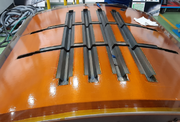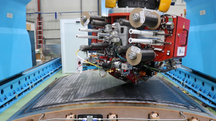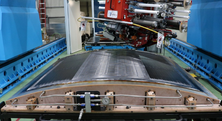ABSTRACT:
Due to the huge interest of the aeronautic industry for finding new solutions in terms of processes and materials to improve performances and to reduce costs, thermoplastic composite materials appeared as an attractive solution. The high temperatures required for processing this kind of materials and the lack of knowledge in the associated manufacturing processes make their application to structural parts more complex compared to that of thermoset composite materials.
The study presented here contains the design and manufacturing of a curved section of a fuselage reinforced with omega stringers and ‘Z’ curved frames. The requirements for designing were taken by considering a preliminary flat demo which was manufactured and tested. Following the manufacturing activities conducted with the flat demo, the stiffeners were obtained by hand lay-up and hot press forming, afterwards they were installed in a tooling with specific cavities and the skin was laminated on top. The lamination of the skin was conducted by using a gantry style machine from the Spanish supplier MTorres. The adhesion of the skin to the stiffeners was possible by increasing the temperature to melting point by using a diode laser.
After laminating the skin, the whole demo was demolded and inspected by non-destructive testing, showing a good quality in terms of the skin consolidation and in the welding line with the stiffeners.
This work was developed as part of LPA project (Large Passenger Aircraft) in the framework of the Clean Sky 2 JU program.
Keywords: thermoplastic fuselage, in-situ consolidation, co-consolidation, curved stiffeners
1. Introduction
The application of technologies as automatic laying-up with composite materials helped to reduce production times and costs [1]. In the case of thermoplastic composites, the automatic laying-up process requires to increase the temperature to the matrix melting point, then, the incoming material and the substrate are bonded together under the force of a compaction roller. The main advantage of this process is the suppression of autoclave or oven secondary cycles, the part after laminating is finished for inspection [2]. The complexities associated to this process are delaying its application to the industry, making necessary to conduct detailed studies of all the physics interacting in the process: thermal transferences [3], degradation [4], crystallization [5], voids collapse or migration and residual stresses.
2. Materials
The material used for manufacturing the stiffeners and the skin was Toray Cetex TC1225 PAEK, with standard modulus carbon fiber T700. For hand lay-up activities (stiffeners), 194gsm material in the format of 12’’ width, was selected. For automatic laying-up (skin), 134gsm material in the format of ¼’’ width was chosen.
As explained below, the part includes reinforced patches. The material used for manufacturing the reinforcements wasHEXCEL AGP-193-PW/8552 RC40.
3. Design
The design of the stacking sequence and the geometry of this demo was calculated by using the results obtained after testing several coupons extracted from a flat demonstrator (skin reinforced with omega stringers and Z frame): filled-hole tension, open-hole compression, bearing, crippling, unfolding and mouse hole tests, conducted by Elements [6].
FIDAMC oversaw manufacturing the flat demo [7] in cooperation with Aernnova.
Figure 1 shows the curved part design where the green areas represent the thermoset reinforcements. The part had simple curvature with a radii of 3000mm and 1300x1150mm global dimension.

|

|
This curved demo was tested under typical fuselage loads, combining shear and pressurization.
4. Manufacturing
Different technologies were used for manufacturing the stiffeners and the skin.
4.1. Stiffeners
Four omega stringers were manufactured by hand lay-up and hot plate press forming by using a dedicated tooling. Two Z-shape frames were manufactured by hand lay-up and hot plate press forming by using a dedicated tooling. A hot plate press from Marzola-Biele Group was used.
One press cycle was used to consolidate each omega stringers, unlike the frames, which needed a first cycle to form the geometry and a secondary one to consolidate.
The stiffeners were located into the cavities of a lamination tooling, specifically designed for this purpose. Each omega stiffener hosted in its cavity two metallic modules to allow lamination, maintaining the shape, and helping to demold. Each Z shape frame hosted a metallic modulus on one side. None of the stiffeners had fillers, the metallic modules were designed to be adapted to these areas.
None of the modulus was self-heated, although the rest of the tool was heated by electrical resistances distributed in the whole area, generating important heterogeneities in the lamination area.
4.2. Skin
The skin was automatically laminated by using a gantry style machine from the Spanish supplier MTorres. Six tows of ¼’’ were placed by heating with a diode laser. Figure 2 shows the tooling before placing the stiffeners (a), the stiffeners after positioning (b) and the lamination process (c & d).
Complete laying-up process was done with self-heated tooling at 200 ⁰C to compensate and prevent from thermal residual stresses. The heterogeneous behavior of the tooling, the stiffeners, and the metallic modulus in terms of temperature highly impact in the thermal distortions experienced by the external metallic modulus and the demonstrator.

(a) |

(b) |

(c) |

(d) |
4.3. Packers
With the purpose of part testing, different areas of the demo were reinforced by bonding patches of thermoset composite material. The patches were cured with the curved shape in oven using vacuum bag and then bonded to the thermoplastic composite demonstrator by using an adhesive film.
Conclusions
A fuselage panel with thermoplastic composite materials was obtained by press forming and automatic laying-up. After non-destructive inspection, good quality was demonstrated in the whole skin panel and in the bonding lines: frames-skin and stringers-skin, which manifest the capabilities of this process to consolidate the skin and weld the skin and the stiffeners. Nevertheless, to permit the industrial scale up of the process, the speed should be improved, and the thermal distortions need to be re-evaluated.
Considering heat transference, a deep study should be conducted to check the impact of isolative or conductive materials in the tooling.
The tests conducted on the final demo demonstrated that the requirements predicted by simulation based on flat panel tests, were fulfilled.
Acknowledgment
This work was supported by the Large Passenger Aircraft (LPA GAM 2019) project [grant number 807097]. The authors would like to thank the European Commission for their financial assistance and for promoting cooperation between research and industry across Europe.
Bibliografía
| [1] | A. Crosky, C. Grant, D. Kelly, X. Legrand y G. Pearce, «Fibre placement processes for composites manufacture,» Advances in composites manufacturing and process design, pp. (pp. 79-92), 2015. |
| [2] | Z. Qureshi, . T. Swait, R. Scaife y H. El-Dessouky, «n situ consolidation of thermoplastic prepreg tape using automated tape placement technology: Potential and possibilities.,» Composites Part B: Engineering, vol. 66, pp. 255-267, 2014. |
| [3] | A. Zaami, M. Schäkel, I. Baran, T. C. Bor, H. Janssen y R. Akkerman, Journal of Composite Materials, vol. 55, nº 8, pp. 1073-1090, 2021. |
| [4] | I. Martín, F. Rodríguez-Lence, A. Güemes, A. Fernández-López, L. A. Pérez-Maqueda y A. Perejón, «On the determination of thermal degradation effects and detection techniques for thermoplastic composites obtained by automatic lamination,» Composites Part A: Applied Science and Manufacturing, vol. 111, pp. 23-32, 2018. |
| [5] | C. Zhang, Y. Duan, H. Xiao, B. Wang, Y. Ming, Y. Zhu y F. Zhang, «Effect of porosity and crystallinity on mechanical properties of laser in-situ consolidation thermoplastic composites,» Polymer, vol. 242, p. 124573, 2022. |
| [6] | K. Muñoz, M. Jiménez, M. J. Mesa, R. Cabrera, S. Anaya, R. Elices, K. Fernández y J. Cuenca, «Allowables Evaluation for the Design of a Thermoplastic Fuselage,» de XIV CONGRESO NACIONAL DE MATERIALES COMPUESTOS, Sevilla, 2022. |
| [7] | I. Martin, K. Fernández, J. Cuenca, C. Sánchez, S. Anaya y R. Élices, «Design and manufacture of a reinforced fuselage structure through automatic laying-up and in-situ consolidation with co-consolidation of skin and stringers using thermoplastic composite materials,» Heliyon, vol. 9, nº 1, 2023. |
Document information
Accepted on 17/12/24
Submitted on 22/05/23
Licence: Other
Share this document
Keywords
claim authorship
Are you one of the authors of this document?

